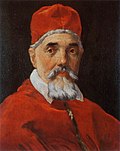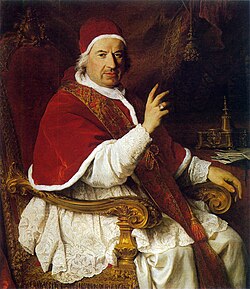Camauro

A camauro (from the Latin camelaucum and from the Greek kamelauchion, meaning "camel-skin hat") is a cap traditionally worn by the pope, the head of the Catholic Church.[1]
Construction
[edit]Camauros are traditionally made of red velvet or silk and white ermine fur, or of white damask fabric with fur for the hat worn during the octave of Easter.[1][2][3] It is constructed with the rear panels shorter than the front panels, so it sits lower on the neck and ears in the rear, providing more warmth and comfort.[2] Its red-and-white construction has lead it to be compared to the hat worn by Santa Claus.[4][5][6][7]
History and use
[edit]
The camauro emerged in the 12th century, originally being worn by both cardinals -- without the fur trim --and the Pope in place of the biretta.[8] It perhaps shares a common ancestor with the zucchetto, another hat worn by high-ranking Catholic prelates.[9][10] In 1464 it was restricted to the Pope, with cardinals wearing the scarlet zuchetto instead.[8] During the Rennaisance era, when the hat appears in a 1512 portrait of Pope Julius II by Raphael, it was a part of the less formal version of papal dress, the choir dress.[11][12] It also was part of the vesture in which the pope was dressed following his death.[13] It was worn commonly by popes up until the latter part of the 18th century, and occasionally used by Pius IX and Leo XIII.[14] While it was worn by Pius XII as part of his funeral rites, neither he nor any of his successors wore it while they were living for 50 years prior.[14]

Pope John XXIII revived the hat with the assistance of papal tailor Gammarelli, wearing it for the first time in an December 1958 audience with the pastors of the city of Rome.[14][5] The sartorial firm recreating the garment, lacking contemporary examples of the headwear, had to base their construction off of rennaisance portraiture featuring the hat.[5]
Benedict XVI also made use of the hat on one occasion in December of 2005, saying that he wore it mainly to keep his head warm but stopped wearing it to avoid over-interpretation.[6][5] Some commentators viewed it as a "pre-Vatican II fashion statement" or "overtly camp", with others saying it is a sign of Benedict's hermeneutic of continuity.[1] Neither Gamarelli nor Raniero Manicelli, another tailor used by Benedict, would comment as to the identity of the manufacturer of the camauro worn by Benedict in 2005.[7]
Gallery
[edit]-
The Easter camauro, with white fur trim and a white damask base.
Notes
[edit]- ^ a b c "Symbols and the "Hermeneutic of Continuity"". Homiletic & Pastoral Review. 21 February 2013. Retrieved 4 May 2025.
- ^ a b Philippi, Dieter (2009). Sammlung Philippi : Kopfbedeckungen in Glaube, Religion und Spiritualität. Internet Archive. Leipzig : Benno. ISBN 978-3-7462-2800-6.
{{cite book}}: CS1 maint: publisher location (link) - ^ Glossarium Artis 8 volumes.
- ^ "Beautiful Liturgy is hard work, Monsignor Guido Marini reminds - Communio". communio.stblogs.org. Retrieved 4 May 2025.
- ^ a b c d "Pope's Santa-like hat is old school". Chicago Tribune. 23 December 2005.
- ^ a b Review, Catholic (26 November 2010). "Why the pope wore that 'Santa hat'". Archdiocese of Baltimore. Retrieved 4 May 2025.
- ^ a b Meichtry, Stacy (24 December 2005). "Holy Father Christmas". The Washington Post. ISSN 0190-8286. Archived from the original on 2 May 2025. Retrieved 2 May 2025.
- ^ a b 1910 New Catholic Dictionary, "Camauro".
- ^ "CATHOLIC ENCYCLOPEDIA: Zucchetto". www.newadvent.org. Retrieved 4 May 2025.
- ^ Nainfa, John Abel (1909). Costume of prelates of the Catholic church [electronic resource] : according to Roman etiquette. Baltimore, Md. ; New York : John Murphy Company.
- ^ Loren Partridge (1 January 1979). A Renaissance Likeness Art and Culture in Raphael's Julius II. unknown library. University of California Press.
- ^ "Modifications to the Rite Approved by Benedict XVI - A Consistory between Tradition and Innovation, Msgr. Guido Marini". www.vatican.va. Retrieved 5 May 2025.
- ^ Moroni, Gaetano (1840). Dizionario di erudizione storico-ecclesiastica da S. Pietro sino ai nostri giorni. Compilazione di Gaetano Moroni romano. Robarts - University of Toronto. In Venezia : Tipografia Emiliana.
{{cite book}}: CS1 maint: publisher location (link) - ^ a b c "Catholic News Service Newsfeeds". Catholic News Service. 22 December 1958.
References
[edit]- Philippi, Dieter (2009). Sammlung Philippi – Kopfbedeckungen in Glaube, Religion und Spiritualität. Leipzig: St. Benno Verlag. ISBN 978-3-7462-2800-6.
External links
[edit]- About the camauro
- The Philippi Collection
- About the skull cap Archived 4 February 2012 at the Wayback Machine
- 'Santa Pope' woos Vatican crowds (BBC News, 22 December 2005))
- History of the Skullcap (PDF, p. 21–22)
- Various popes wearing the camauro on a church watching blog
- Pictures of Camauro and other clerical headgear, information and literature in German language
- Picture with summer-camauro in amaranth red silk, white camauro in silk-damask worn during the Octave of Easter and winter-camauro in red velvet





